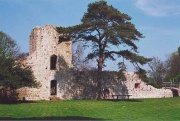Rose & Power
This is a spot on the A20 south of Sellindge. RH provides the following illumination from Kent by Roger Higham (B.T. Batsford Ltd., 1974), which bears quoting at length:
It is near Postling that the East Stour springs from the hillside, close under the escarpment of the Downs ... The infant river flows down to Stone Street and the village named from it, Stamford; it runs then under the road and under the railway near Westenhanger station (which functions as a phantom station, without staff), round the back of Folkestone Racecourse and around the remains of a battered old manor-house, Westenhanger House. This place is only reached through the litter-strewn rear parts of the racecourse and would be better seen from the train if longer than two seconds were permitted. There is a legend which says that Rosamund Clifford, Henry II's unfortunate mistress, lived here, and one of the two surviving towers is known as "Fair Rosamund's Bower"; the towers in question, along with the remaining fortifications, were not built until the fourteenth century, so this seems unlikely.
(EB's map and tour of the area managed to overlook that—but (as the desperate imagination must find its own way) did turn up a nearby house called Rose Cottage, and the resemblance of the Folkestone Racecourse itself to a "Power Ring" of modest scale.)
TH elaborates on Rosamund's fate, citing Anthony Roe:
One legend recounts how [Queen] Eleanor penetrated the maze set to protect Rosamund and offered her a choice of poison or the dagger. Another version is that the queen arranged for her to be bled to death in a bath. It is however almost certain that Eleanor never met Rosamund, and this prospect of blood-letting is an overlay echoing ancient beliefs attached to the rose and the love escapades of ancient Goddesses. The labyrinth may have been a maze of rose-bushes, and Rosamund's bower was assuredly decked with rambling roses, tokens of the king's affection. It is curious to note that further legends refer to the shrine wherein Henry's Rose of the World was buried. Upon the exhumation the venerated grave exhuded a sublime perfume and exhibited no corruption, as later was to be experienced by those who discovered the tomb of Christian Rosencreuz, the mythical founder of the Rosicrucian movement. The rose is symbolic of that which is undying.
(96)
